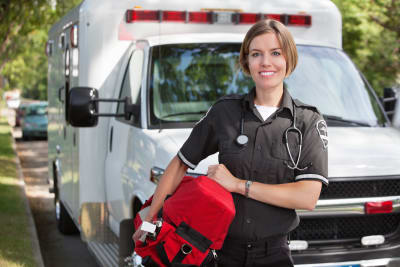Becoming an EMT can be a fulfilling experience. Not only do you get to save lives in real-time, but you also get to be the first significant chance at survival for many people across your career. You also enjoy a decent salary with a veritable opportunity for consistent growth.
So yes, it can be rewarding to become an EMT. However, finding out how to become one can be challenging - especially if you’re trying to figure it all out on your own.
And that is why we have provided the detailed guide below highlighting virtually every critical thing you need to know to become an EMT.
But first, a quick refresher of what an EMT does in the first place.
Who is an EMT, and What Do They Do?
An EMT is trained to provide care outside the hospital, usually at scenes of emergencies. They provide first-aid to casualties, stabilize them, and, depending on their qualification, act as a primary caregiver on the way to a medical facility or hospital.
EMTs are pretty different from paramedics. While the former can only perform noninvasive interventions, the latter can perform invasive maneuvers such as injecting epinephrine into the skin of a casualty already having a severe allergic reaction.
EMTs can be found working in private and private ambulances, fire departments, air rescue teams, and private ambulances. In Urban settings, they can be found working hand in hand with more extensive clinical networks and police stations.
How to Become an EMT
One of the most appealing parts of being an EMT is that there are about four distinct levels of proficiency. This allows prospective applicants to start from a lower level of qualification and work their way up while gaining valuable real-time experience.
Below are the different steps or career paths to becoming an EMT.
Starting as an EMR
A high school diploma or GED is needed to become an EMR - short for “emergency medical responder” -. Candidates with this only have to complete an NREMT-accredited EMR program, which lasts about four weeks maximum with 65 hours of training instructions.
Once candidates are done with the program, they must pass a cognitive and psychomotor exam. The National Registry administers the mental exam containing 90 - 110 questions.
The state administers the psychomotor exam or is outsourced to a third-party institute.
Moving from EMT-Basic to Advanced EMT
An EMR wishing to attain a higher qualification can enroll in an accredited EMT-Basic program. Candidates who want to skip EMR and register for direct EMT programs can also do so.
The NREMT also carries out program accreditation. The 120 hours of training in EMT programs must be completed within a 2-year. Once candidates are done with the program, they must complete and pass cognitive and psychoactive tests.
From EMT-Basic, one may proceed to advanced EMT programs. Advanced EMTs can do everything regular EMT-basics do, along with a limited number of invasive interventions.
Advanced EMT programs require approximately 350 hours of learning. A different set of cognitive and psychomotor tests must also be completed and passed.
Becoming a Paramedic
Paramedics are a tier above advanced EMTs. Unlike the latter, paramedics can perform a wide range of invasive interventions, including tube injection. Becoming a paramedic also involves registering for an accredited program.
Paramedic programs must also be completed within two years and consist of up to 1800 hours of instruction. They deal with more advanced aspects of emergency response, such as cardiology, anatomy, and pharmacology.
An essential paramedic certification requirement is completing an internship program in a hospital or ambulance.
Cognitive testing of 80 - 150 questions is done at the end of the program, followed by psychomotor tests, which candidates either PASS or FAIL with no further detail.
Background Checks, Documentation & Licensing
States typically require candidates to pass a background check before they’re allowed to practice as EMTs. Among other things, they must have no criminal background. In California, for example, candidates must complete live fingerprinting checks transmitted to the DOJ for vetting.
Additionally, most states require EMTs to be licensed before practice. Licensing is not the same as certification.
What to Expect as an EMT
Being an EMT can be quite tasking physically. It also requires a lot of mental strength and problem-solving. Depending on where they work, an EMT can work night shifts, weekends, and even holidays.
It is also worth mentioning that despite the flashing emergency lights and police taps that are pervasive of EMT characterizations on TV, a day in the life of an EMT does not necessarily tend to be that chaotic. Most EMTs deal with milder cases - which, of course, still require a great deal of life-saving and patient care, and as such, can be just as fulfilling.
Career Furthering Opportunities
EMTs may choose to leverage their knowledge, skills, and experience to seek career growth opportunities in healthcare. Although some EMTs do this by becoming advanced paramedics, others choose separate routes.
Among the options available in this regard is to move to a career as a firefighter. Others also choose to be emergency management directors, dental hygienists, or even registered nurses.
There are so many incredible, exciting careers in healthcare, and the sky is the limit for those willing to work hard and improve themselves.
Pursuing A Career As An EMT
EMTs are emergency medical technicians dispatched to scenes of emergency to provide first aid and help transport patients to appropriate medical facilities. To become an EMT, you must have a diploma or GED, CPR certification, and complete an accredited EMT program.
After completing the specified cognitive and psychomotor tests, EMTs may advance their careers by becoming advanced EMTs or paramedics. The required steps for doing these have been highlighted in detail above.




